Do not view stability as some supreme myth. I have immersed myself in the trading field for ten years, fully dedicated for six years, enjoying a carefree life rhythm, almost insulated from stress. The profits brought by this stability are far beyond what ordinary office workers can reach. However, to be pragmatic, it also has its limits and is definitely not the infinite wealth some people fantasize about.
After six years of ups and downs, I gradually explored a trading path that fits myself under the guidance of a wise person. Though I can't say I've entered the ranks of the wealthy, stable profits are already within reach, allowing me to easily surpass over 90% of my peers.
Long ago, I understood the tremendous help that an excellent trading system provides to investors. At the same time, I also know that blind investment without systematic guidance is akin to repeatedly losing in a gambling arena. However, establishing an effective trading system is no easy task. A truly excellent trading system often goes against human nature; it requires you to abandon greed and fear, maintain calmness and decisiveness, reject subjective assumptions, and strictly execute established strategies.
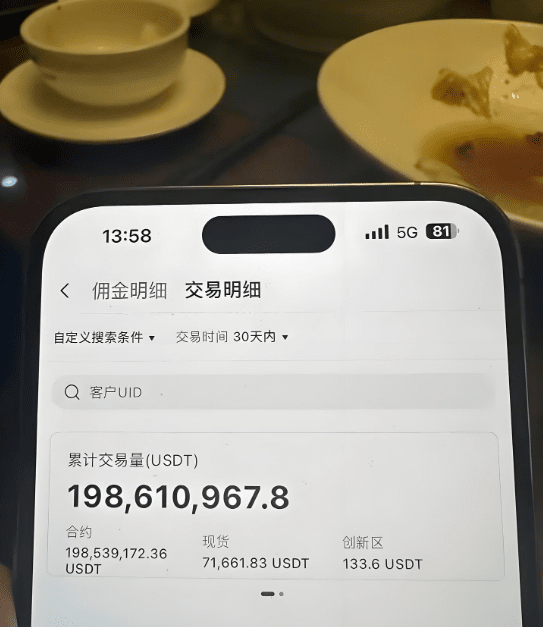
Welcome everyone to my knowledge sharing series. The purpose of this series is to guide everyone step by step in learning and judging various situations in the market.
The outline for sharing knowledge can be summarized as follows: starting from the bottom indicator area, then leading everyone to understand the candlestick charts in the price trend area, while also interspersing some macro concepts such as Dow Theory, Elliott Wave Principle, etc.
Looking at the overall analysis chart, it is mainly divided into price trend areas and indicator areas. We will gradually build a foundation for everyone, with the main content of the first lesson focusing on the MACD indicator.
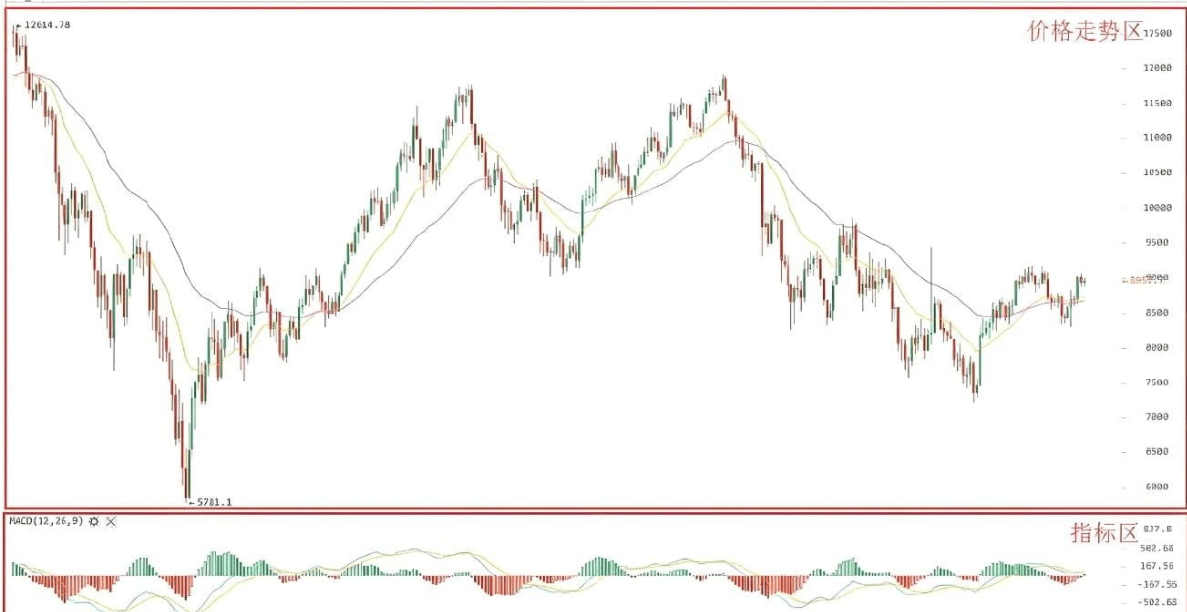
The MACD indicator, also known as the Exponential Moving Average Convergence Divergence, is developed from the double exponential moving average. In simple terms, it reflects the convergence and divergence between short-term and long-term moving averages, representing the current bullish and bearish state and possible price trends. However, it is more convenient to read, and we often mention MACD in Xiaofang's essays.
MACD consists of the blue line DIF, the yellow line DEA, and the histogram. The zero axis is the central axis, with values above 0 indicating strength and below 0 indicating weakness. A blue line crossing above the yellow line is a golden cross, while a blue line crossing below the yellow line is a death cross.

1. In theoretical knowledge, when MACD turns from negative to positive, it is a buy signal. When MACD turns from positive to negative, it is a sell signal. When MACD changes at a large angle, it indicates that the difference between the two moving averages is widening rapidly, representing a significant market trend change.
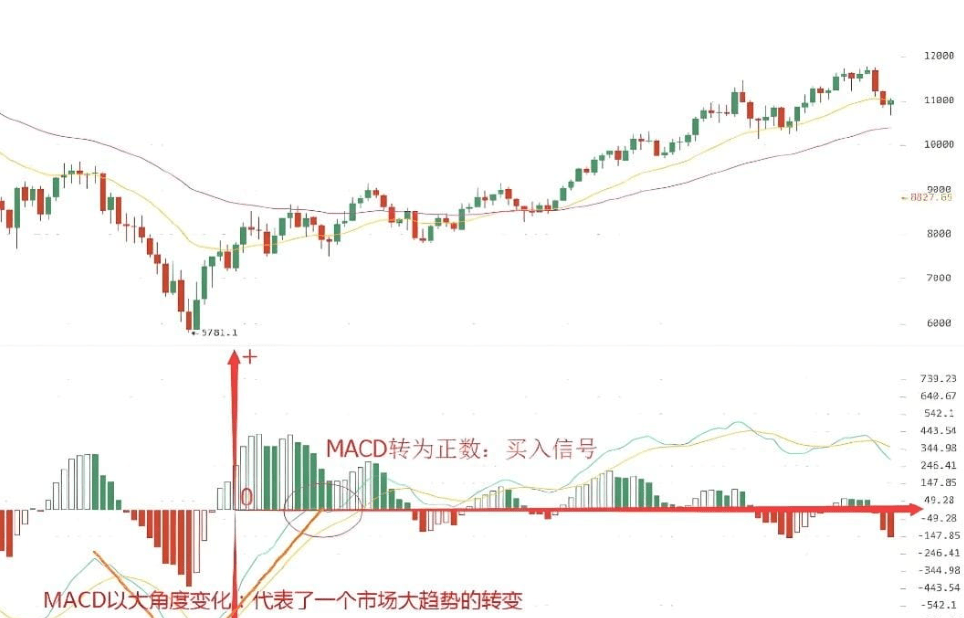
Secondly, in practical operations, MACD has two main functions: one is to judge trends, and the other is to judge corrections or reversals through divergences.
1. Buy at golden crosses and sell at death crosses
In simple terms, it means chasing highs and cutting losses. In a bull market, buy at golden crosses; in a bear market, sell at death crosses. However, in practice, it often requires predicting golden and death crosses, but the dealers will certainly not make it that easy for you to analyze the trend, requiring a combination with other indicators for further action.
2. Sell at top divergences and buy at bottom divergences
Generally, MACD indicators should move with stock prices. However, due to certain factors, sometimes the indicator cannot synchronize with prices, leading to the divergences that everyone often sees. Simply put, divergence is when there is a different trend between price and indicators.
Mainly divided into two types:
(1) Top divergence: Price reaches a new high while the MACD indicator declines.
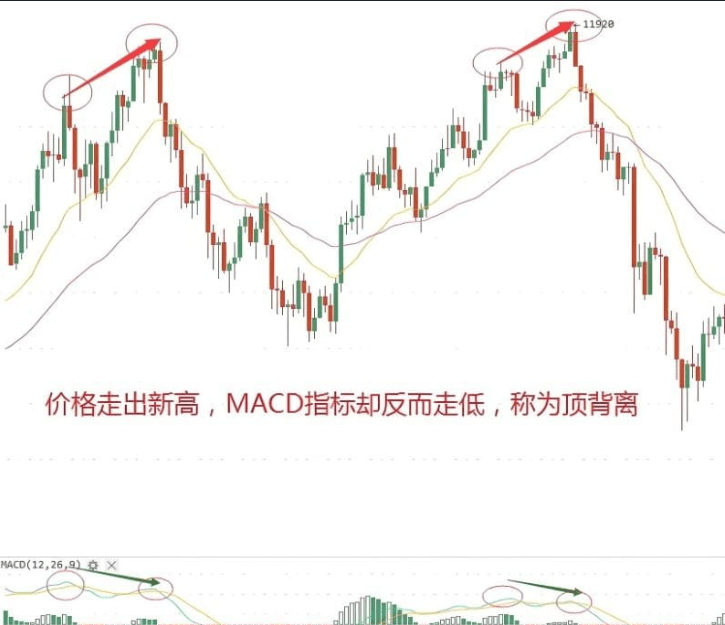
(2) Bottom divergence: Price declines while the MACD indicator rises.
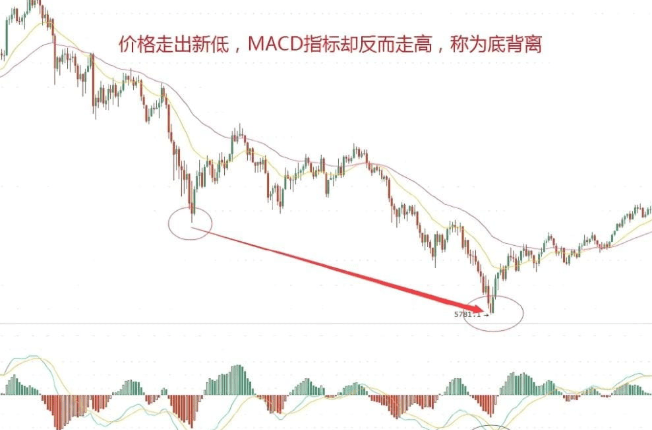
In practice, it is often summarized as escaping the peak and bottom trading. Selling at top divergences and buying at bottom divergences. In a rising market, prices continually reach new highs, and moving averages show a perfect bullish arrangement. If only looking at price and moving averages, it seems the rising trend has not reached its end. However, after multiple waves in the market, some changes seem to have occurred, and the top divergences in MACD often remind everyone that such trends may end at any time.
MACD is a commonly used technical indicator. Basically, on the trading interface of any financial product, the first auxiliary chart is MACD. The fact that so many people use it shows that it is indeed useful. Additionally, the more people use it, the more feedback it generates for the market. When everyone sees this signal, their actions based on this signal will create feedback for the market, and this signal will truly drive market fluctuations. Therefore, whether you are a technical trader or not, you must have a detailed understanding of MACD.
Everyone can find the basic uses of MACD, so I won't elaborate here. However, you have also discovered that those textbook teachings seem like truths, but using them does not yield profits. This is because those who write books are often eliminated by the market; they write books because they cannot make money in the market. Here, I will share some truly practical uses.
Advantages and Disadvantages of MACD
To understand an indicator, one must first know its advantages and disadvantages, when it cannot be used, when it is not useful, when it is ineffective, and when it is best to use. MACD is a trend indicator with a very high accuracy rate, but it also has obvious drawbacks, as it lags severely. The high accuracy means we can use it as a trend indicator, and the accuracy is higher over longer periods; it will only make mistakes during market transitions. The severe lagging indicates that it is difficult to find perfect buying and selling points with this indicator. If using MACD to find buying and selling points, it is important to clarify that we only catch the belly of the fish, or even just a part of it; only by clarifying this can we use MACD to find buying and selling points.
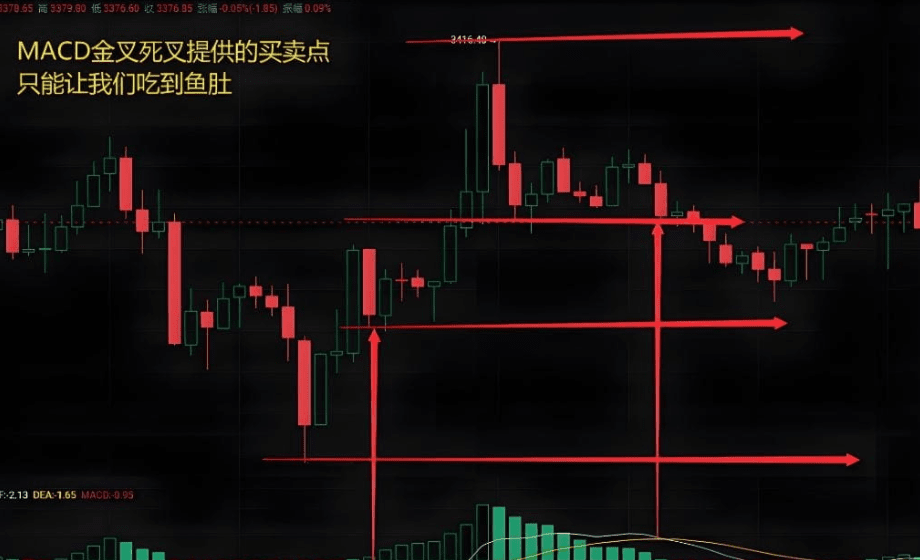
Zero Axis
The zero axis of MACD can be seen as the boundary between bullish and bearish trends. Below the zero axis is a bearish trend, and bullish signals should not be entered; even if entered, it should be a light position and quick in and out. Bearish signals can be held as a trend. Above the zero axis, the opposite applies. The golden cross and death cross signals formed near the zero axis are called zero axis golden cross and zero axis death cross, which are more effective bullish and bearish signals.


Divergence
Divergence is a relatively practical form in MACD. Normally, price and indicators are proportional. When price and indicators continuously move in opposite directions, it is called divergence. When price rises and the indicator falls, it indicates that the rise is problematic, as is the case with bottom divergence.
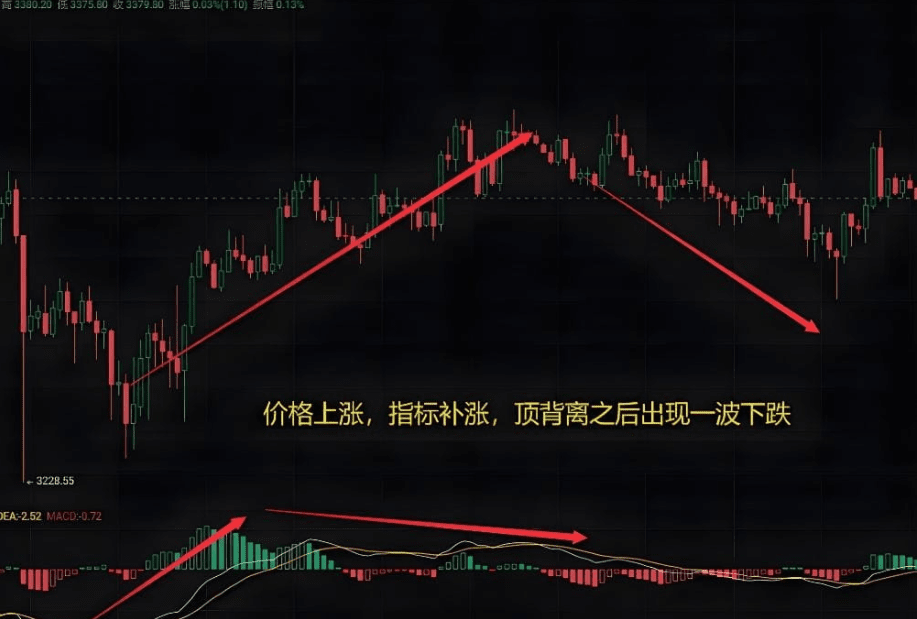
It should be noted that the cryptocurrency market occasionally experiences low-probability unilateral trends. During these times, divergences become ineffective. This can be easily filtered out by observing the strength of the movement. When the strength of the rise or fall is very significant, such as a rapid increase or decrease in a very short time, it indicates that the main force is controlling the market. At this point, technical indicators become ineffective, and divergences, no matter how accurate, will continue to diverge.
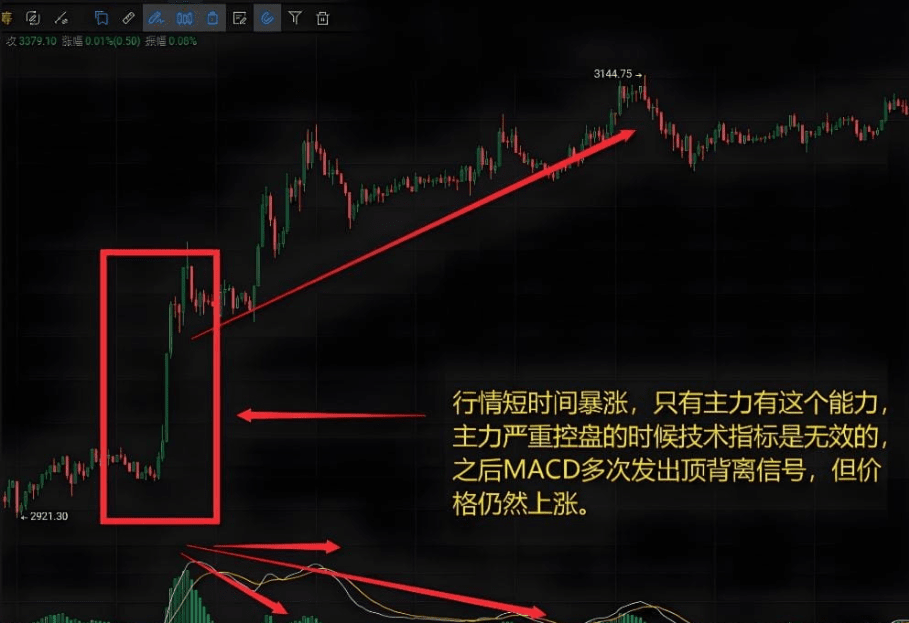
Technical indicators are tools for us to observe the market. Since everyone is looking at them, it means they are useful. Even if they are not useful, because all investors are observing them, they can become useful, as the market itself is determined by the actions of countless investors. However, one must be aware that many times technical indicators are ineffective or not useful. Every technical indicator has its drawbacks; the more useful the indicator, the more obvious its drawbacks. Learning to use a technical indicator requires first understanding its shortcomings and leveraging its strengths to bring us stable profits.
In summary, the role of the MACD indicator is significant, but due to intentional operations, novices are often misled. I emphasize again that we need to combine it with other indicators for further action. To think more broadly, we must view it from a macro perspective and never focus solely on one indicator. This is something everyone must remember.
Finally, let me share a set of 11 bloody lessons from the cryptocurrency world! Seeing is understanding!
1. Not acting in a sideways market is winning
If sideways for more than 5 days, with no clear winner between bulls and bears, guessing is just giving away money. In 2018, BTC was sideways for 8 days; I invested 100,000, and on the 9th day it plummeted, losing 70,000—watching is worth 10 times more than acting.
2. Popular coins must move within 3 days
Popular coins rise quickly but cool down even faster. I chased a popular coin, made a 20% profit on the first day, got greedy, and on the third day the project team dumped it, losing 80% overnight. Rule: If someone in the group shouts 'get rich', reduce your position; if someone curses, close out.
3. Strong trends should be held firmly
In 2021, ETH gapped open high at 100 dollars, and someone in the group shouted 'trap', but the volume broke the previous high + the 20-day moving average turned upward, signaling a main rising wave. I gritted my teeth and didn't sell, ultimately making 800,000—don't let 'fear of heights' scare you off.
4. Take profits on large bullish candles first.
A large bullish candle at a high position means the main force is calling for others to接盘. When BTC surged to 48,000, the trading volume was three times that of the previous day. I reduced my position by 60%, and the next day I adjusted to secure profits. On large bullish candles, take half profits first.
5. The 20-day moving average is a safety belt
Buy on rebounds and sell on pullbacks. The 20-day line is the market cost line: most people profit above it, and the trend is upward; most people lose below it, and the trend is downward. Follow the trend and do not be beaten down by the larger trend.
6. Three non-rules: do not sell on highs, do not buy on dips, do not act during sideways movements.
A few years ago, I changed 3 coins in one day and paid tens of thousands in fees, which was worse than doing nothing. Buying low and selling high waits for signals, not random movements, which can filter out 80% of ineffective trades.
7. Always diversify, with a maximum of 10% position size.
I've stumbled into the pit of losing 50% on all altcoins. Even if I am 100% optimistic, I will invest at most 10%. Keeping cash means having bullets; someone who goes all-in will lose everything if they win 9 times and lose once.
8. Look at funding trends for good and bad news
A coin that has received 'huge investment from giants', if it drops after the good news = false good news, run quickly; regulatory bad news, BTC drops 5% and then rebounds = truly resilient, can increase positions. The market is more honest than the news.
9. Fewer indicators are better, 3 are enough
MACD looks at trends (golden crosses and death crosses), Bollinger Bands look at emotions (upper band overbought, lower band oversold), and volume distinguishes truth from falsehood (only real rises occur with increasing volume). Only when all three signals align is the success rate high.
10. Write a plan for every trade
Write clearly before buying: what to buy, position size, stop loss, take profit. In the past, I bought based on feelings, didn't know when to sell when it rose, and was reluctant to cut losses when it fell. Writing a plan can help control impulsiveness, and even if there are losses, they are understood.
11. Stop losses and take profits are lifelines.
If a single coin drops more than 3% (up to 5%), cut it. If it rises to the target, sell half first. In the bear market of 2022, I relied on a 3% stop loss, keeping losses to 15%; in this bull market, I relied on 'selling half' to secure profits. Surviving is key to making big profits.
To be honest: when I was at my most difficult, I only had 30,000 left. The ability to rise is not due to intelligence, but understanding that 'discipline is what counts in the cryptocurrency world.' Now I don't stay up late, don't overtrade, accompany my child on walks, and earn 100,000 a month for household expenses, while my account continues to grow.
By following these rules, you too can earn steadily.
These 11 trading logics are the hard-earned experiences after practical losses, focusing on 'discipline, rationality, and risk control':
During sideways movements, hold back your hands and do not guess the direction;
Take profits on popular coins quickly, do not be attached to battles;
When the trend strengthens, hold firmly without being disturbed by short-term fluctuations;
Take profits quickly on large bullish candles to avoid the risk of false signals;
Use moving averages as trend anchors and do not operate against the trend;
Follow the principle of 'Do not sell on highs, do not buy on dips, do not act during sideways movements', to filter out ineffective trades;
Always diversify your positions and keep enough cash to seize opportunities;
Do not be influenced by news headlines; keep a close eye on the real reactions of market funds;
Simplify indicators and focus on signal resonance;
Write a plan for every trade in advance, defining buying and selling points, position size, and stop losses and take profits;
Treat stop losses and take profits as lifelines, using strict rules to protect capital and secure profits.
Ultimately, making a profit in the cryptocurrency world does not rely on luck, but on suppressing greed with rules and controlling risks with rhythm. Maintaining discipline is key to surviving and steadily profiting through bull and bear markets.
Even the most diligent fisherman would not go out to sea during a storm but would focus on protecting his fishing boat. This season will pass, and a sunny day will eventually come! Pay attention to the banquet and learn how to fish and fish for a lifetime. The door to the cryptocurrency world is always open; only by going with the trend can one have a life that flows with the current. Collect this and remember it in your heart!


